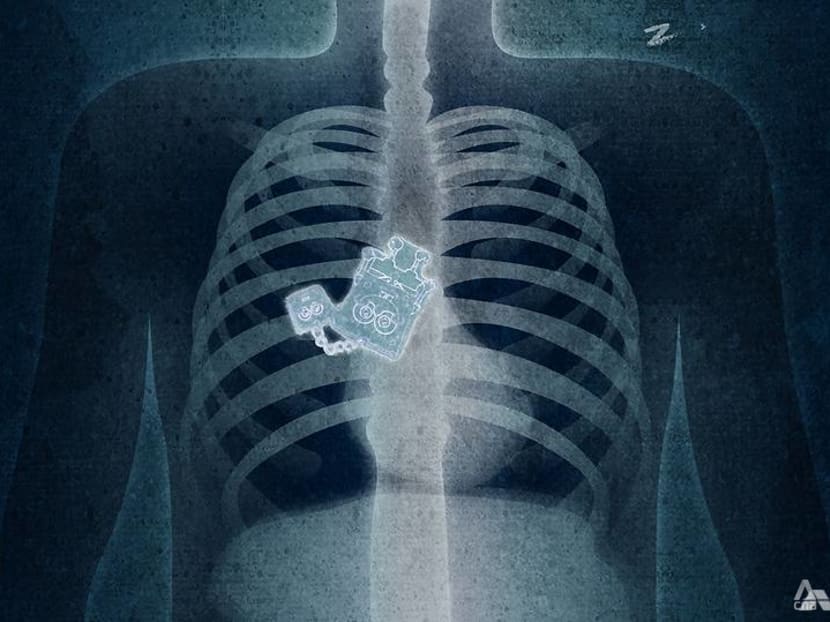What to do when you've swallowed something you shouldn't have
It might be surprising to know that the classic signs of choking – like coughing – aren't always present when you swallow fish or chicken bones. Or SpongeBob SquarePants.

(Art: Chern Ling)
A man was brought to the hospital, experiencing severe pain in the chest and back.
This could be a sign of a major heart, lung or blood vessel emergency, thought Dr Michael Fung, consultant with the Acute And Emergency Care Department at Khoo Teck Puat Hospital (KTPH), a member of the National Healthcare Group.
As it turned out, the man was found to have a chicken bone stuck in his oesophagus.
It might be surprising to know that the classic signs of choking – like coughing – aren't always present when we've swallowed something we shouldn't have.
Apart from the usual suspects such as fish, chicken and frog leg bones, fruit seeds, and meat or vegetable boluses, local doctors have also pulled stranger objects, such as dentures and broken spoon shards, from the oesophagus – and sometimes, further down the digestive system.

Pins, needles and paperclips, said Dr Ker Liang, a consultant with National University Hospital's (NUH) Department Of Otolaryngology (ENT) – Head & Neck Surgery, "are commonly held between the patient’s lip while working and inadvertently swallowed by mistake".
“We’ve had a patient with fever come in,” said Dr Fung, and that fever was caused by a deep abscess in the patient’s rectum, which was eventually found to be the result of an impacted fish bone.
It had passed through his intestine and lodged itself in the rectum, where it resulted in a painful collection of pus.
WHO SWALLOWS?
An average of 10 patients who've swallowed something dubious come through the NUH Emergency Medicine Department on a daily basis, while KTPH’s emergency room saw 15 choking cases last year out of an average of 138,000 patients yearly.

Babies and toddlers are the biggest swallowers of things, said Dr Karthik Balakrishnan, assistant professor of otolaryngology at the Mayo Clinic.
“They explore the world in many ways, including putting things in their mouths. They don’t know what should go in and what shouldn’t so things can accidentally be swallowed.”
Case in point: SpongeBob SquarePants, spotted not in a pineapple under the sea but on the X-ray of a 16-month-old boy. The toddler from Saudi Arabia had been brought to the hospital for swallowing something.
What doctors didn’t expect was a pendant of the grinning cartoon character that had belonged to his sister, said Dr Ghofran Ageely, a radiology resident at King Abdulaziz University Hospital in Jeddah.
Then, there are the unusual items that people have intentionally put down their throats.
Take the case of the drunk 18-year-old student from Bournemouth University in England, for instance. He didn’t want a night of partying to end, so he sent his room key down the hatch to prevent his friends from taking him back to his dorm, according to Mental Floss.
Luckily for him, doctors told him that the keys would “reappear” without surgery.
Individuals with certain psychiatric issues or dementia may also feel compelled to swallow non-food items. “They just seem to have a need to swallow things,” said Dr Troy Madsen, associate professor at the University Of Utah School Of Medicine. “For them, swallowing things feels good.”
In fact, in a 2010 study published in Clinical Gastroenterology And Hepatology, the medical intervention that is needed to remove swallowed foreign objects largely involved patients with psychiatric disorders.

WHEN TO SEE A DOCTOR
Choking occurs when “the foreign object passes down the back of the throat into the airway instead of the oesophagus,” said Dr Fung. “If it is large enough to block the airway, the person will be unable to breathe or speak.”
When this happens, no oxygen can enter the lungs. The brain is the first organ to be affected and begins to die within four to six minutes. Irreversible brain death can occur in as little as 10 minutes.
Urgent cases also include those with signs such as vomiting blood, chest pain, abdominal pain or distension, and blood in the stools, said Dr Fung.
"Medical attention should definitely be sought if the swallowed object was sharp and pointy as it could tear a hole in the digestive tract,” he said.

According to Dr Ker, most patients are "well after the choking episode but have throat pain" from the choking and coughing.
Even so, all patients should see a doctor immediately, she advised. "Most items take about 24 to 72 hours to travel from the mouth to the end of our alimentary canal," said Dr Ker.
"Larger items may take a longer time to travel down. The larger the item, the higher the risk of getting stuck, which may lead to dangerous intestinal obstruction. Surgery is often necessary to remove these large items before they enter the intestines."
WHEN TO DO THE HEIMLICH OR OTHER TECHNIQUES
Many people would think “Heimlich manoeuvre” when they see someone choking. But the technique can cause “serious abdominal injuries”, said Dr Fung.
“There was also a report of a shoulder injury sustained by the well-intentioned person performing the manoeuvre. “It is important to be properly trained in a basic life support course before attempting the manoeuvre.
"Additionally, it is important to explain one's intentions to the choking person and obtain his or her agreement before proceeding,” said Dr Fung.

The move involves standing behind the choking person, wrapping your arms around him, and performing a fist thrust into his upper abdomen. “The impacted object does not ‘fly out’ as it comes free. Usually, it dislodges and ends up in the back of the person's oral cavity,” he said.
If the choking is mild and occurs in an adult, another way to help is to encourage him to cough, said Dr Ker. This is when the person is usually able to still speak, cry, cough or breathe.
But when it is a more severe case of choking, and coughing doesn't help, Dr Ker suggested carrying out five back blows:
- Stand behind the person, slightly to one side.
- Lean him forward and support his chest with one hand.
- Use the heel of your hand (firm, bony area between the palm of the hand and the wrist) to deliver five blows between the shoulder blades.
If the blows don't work, Dr Ker said to proceed with five abdominal thrusts:
- Stand behind the person.
- Place your arms around his waist and bend him forward.
- Clench a fist and place it right above his belly button.
- Put the other hand on top of your fist and pull sharply inwards and upwards.
If the thrusts still don't make a difference, call 995 for an ambulance and inform the operator that you have a choking situation.
Continue with the back blows and abdominal thrusts until help arrives, said Dr Ker. "If the person loses consciousness and is not breathing, you should begin cardiopulmonary resuscitation (CPR) with chest compressions."






